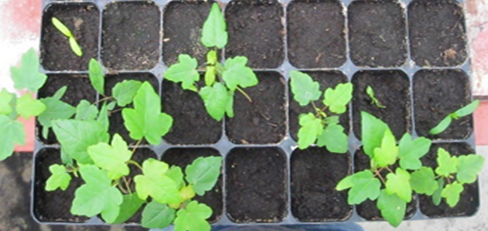
The Montpellier maple (Acer monspessulanum L.) is a Mediterranean and West Asian species considered in Tunisia as rare with only three locations. The ecological importance of the species as a broadleaf and its effects on its natural ecosystem leads us to get a clear idea of the best way of propagation using seeds.
Acer monspessulanum is an 8m high tree located in Tunisia at the highest mountains of Serj, Bargou, and Zaghouan. This work is part of a doctoral thesis to study this species in Tunisia. Driven by the fact of its natural and ecosystem importance and its observed capacities of concurring hard and unusual rocky soils.
A general characterization of the Montpellier maple seeds gives us a general idea about their dimensions with 1.9 cm length x 0.5 cm width, and a weight of 3.7 g for 100 seeds. The seed viability test was about 55%. Among all the treatments tested, only putting the seeds in Petri dishes with filter paper soaked in water at a temperature between 3 to 5 °C in seeds bank for 3 months gave as good results. The germination rate was about 47% and the plant transplantation success rate was 62.5% at a local nursery.
The situation of the Montpellier maple in Tunisia is alarming especially in Bargou and Zaghouan mountains, and to avoid this situation we recommend the following steps to conserve this species:
- Collect mature seeds between October and November
- Clean the seeds and conserve them in low temperature.
- Put 10 seeds in a petri dish with water and 2 filter paper and put them under a cold temperature of 3 to 5°C
- Make sure that the water doesn’t dry out
- Transplant the germinating seeds into a mix of peat and sand with a temperature of 25°C.
Help improving the situation of a rare species such as Acer monspessulanum in Tunisia is an important step. Also, having a result in germination and transplantation of seeds and plant species is always a good step to improve its situation. The test germination was held in a controlled situation and with only one provenance. The germination rate, which is better than what was cited in other works, but appear also low.
Knowing the best way of propagating a species is always a cumulative work whish needs continually amelioration and sharpening, as for the work that we’ve done, for now, we should concentrate on applying more treatments for the seeds always with considering frost condition. Also, seed sources should be multiple to help increase the genetic variability of plants.
Hamdi Aouinti, hamdiiouinti@gmail.com, www.inat.tn
Issam Touhami, issam_touhami@yahoo.fr, www.inrgref.agrinet.tn
Abdelhamid Khaldi, khalditn@yahoo.fr, www.inrgref.agrinet.tn
Further information
Pottier-Alapetite, G., 1979. Flore De La Tunisie : Angiospermes-Dicotylédones : Apétales -Dialypétales. 1e éd. Tunis : le Ministère de l'Enseignement Supérieur et de la Recherche Scientifique et le Ministère de l'Agriculture.
Zare, A., 2014. A Study of Different Treatment Effect On Seed Germination Characteristics and Seedling Survival Montpellier Maple (Acer Monspessulanum Subsp. Turcomanicum Rech. F.). Indian Journal of Fundamental and Applied Life Sciences, 4(4), pp. 455-464.
Issam Touhami and Hamdi Aouinti

Hamdi Aouinti
